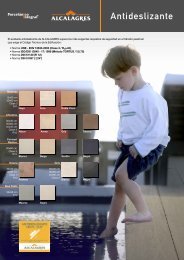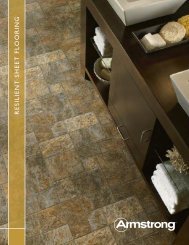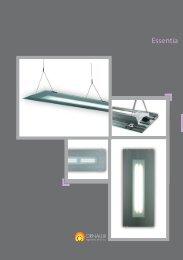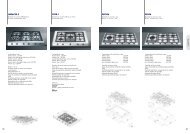manual de colocación de baldosas cerámicas - Habitissimo
manual de colocación de baldosas cerámicas - Habitissimo
manual de colocación de baldosas cerámicas - Habitissimo
Create successful ePaper yourself
Turn your PDF publications into a flip-book with our unique Google optimized e-Paper software.
Método <strong>de</strong> <strong>colocación</strong>:<br />
El sistema <strong>de</strong> <strong>colocación</strong> recomendado para el gres porcelánico<br />
que fabrica GRESPANIA, S.A., es el <strong>de</strong> aplicación <strong>de</strong> adhesivo<br />
en capa <strong>de</strong>lgada. Este sistema queda explicado<br />
<strong>de</strong>talladamente en el punto 6 (pg.26) “Colocación con colas-<br />
Pavimento ” <strong>de</strong> este <strong>manual</strong>.<br />
> Casos especiales:<br />
> Porcelánico rectificado.<br />
Tanto el material <strong>de</strong> agarre como el <strong>de</strong> rejuntado es el mismo<br />
que se ha mencionado anteriormente. Lo que sí es necesario<br />
reseñar es el especial cuidado que se <strong>de</strong>be tener con las<br />
piezas rectificadas en su <strong>colocación</strong> para no romper los bor<strong>de</strong>s<br />
<strong>de</strong> las piezas que se encuentren en contacto.<br />
> Doble encolado.<br />
Es posible que con formatos gran<strong>de</strong>s existan problemas <strong>de</strong><br />
falta <strong>de</strong> adherencia. En este caso se pue<strong>de</strong> recurrir a la técnica<br />
<strong>de</strong>l doble encolado. En esta técnica se aplica el adhesivo<br />
tanto sobre el soporte, presionándolo y peinándolo con la<br />
llana, como sobre el dorso <strong>de</strong> la pieza, en don<strong>de</strong> se aplica<br />
con la parte lisa <strong>de</strong> la llana una fina capa <strong>de</strong> adhesivo.<br />
> Mantenimiento y limpieza:<br />
El mantenimiento y limpieza <strong>de</strong>l gres porcelánico no varía<br />
mucho respecto a las <strong>de</strong>más <strong>baldosas</strong> <strong>cerámicas</strong> (ver punto<br />
8 <strong>de</strong>l <strong>manual</strong>) con la salvedad <strong>de</strong> que, <strong>de</strong>bido a las gran<strong>de</strong>s<br />
propieda<strong>de</strong>s resistentes que posee, resulta posible incluso<br />
para manchas muy persistentes, el empleo <strong>de</strong> un <strong>de</strong>tergente<br />
ácido comercial (que no proceda <strong>de</strong>l ácido fluorhídrico HF)<br />
diluido en agua.<br />
> A<strong>de</strong>cuaciones al uso:<br />
Las excelentes características técnicas que posee el gres<br />
porcelánico, tales como la bajísima absorción <strong>de</strong> agua que<br />
garantiza la resistencia a la helada, la elevada resistencia a<br />
la flexión y a la abrasión, unido a una gran belleza estética,<br />
hace que las posibilida<strong>de</strong>s <strong>de</strong> colocar el gres porcelánico<br />
en diferentes recintos, por exigentes que estos sean, resulten<br />
muy elevadas. De esta forma el gres porcelánico se pue<strong>de</strong><br />
colocar tanto en exteriores como en interiores, en zonas<br />
resi<strong>de</strong>nciales o <strong>de</strong> servicios y en locales <strong>de</strong> mucha concurrencia<br />
como por ejemplo hoteles, centros comerciales, restaurantes,<br />
terrazas...<br />
> Tile-laying method:<br />
The procedure recommen<strong>de</strong>d for laying 30 x 30 cm and 45 x<br />
45 cm porcelain floor tiles ma<strong>de</strong> by GRESPANIA is to use a<br />
thin layer of adhesive. This system is <strong>de</strong>scribed in <strong>de</strong>tail in<br />
point 6.2. above (Laying with glues).<br />
> Special cases:<br />
> Rectified porcelain tiles.<br />
Both the bonding material and the grouting material are the<br />
same as those mentioned earlier. However, special care must<br />
be taken in laying rectified tiles to ensure that the edges of the<br />
tiles are not damaged when they are laid up against other tiles.<br />
> Double bonding.<br />
It is possible that adhesion problems may occur with tiles<br />
measuring 45 x 45 cm. In view of this, it is advisable to use the<br />
double-bonding technique, whereby adhesive is applied to the<br />
both the tile-laying surface and the tile. Apply adhesive to the<br />
tile-laying surface by pressing it and combing it with the trowel;<br />
apply a thin layer of adhesive to the tile using the smooth part<br />
of the trowel.<br />
> Maintenance and cleaning:<br />
Porcelain floor tiles require similar maintenance and cleaning<br />
to any other type of tile (see point 8 in this <strong>manual</strong>). However,<br />
as these tiles are extremely resistant, it is also possible to use<br />
a commercial <strong>de</strong>tergent acid (so long as it is does not <strong>de</strong>rive<br />
from hydrofluoric [HF] acid) diluted in water to remove extremely<br />
persistent stains.<br />
> Adaptations according to use:<br />
The excellent technical specifications of porcelain tiles,<br />
such as their low water absorption, which ensures that they are<br />
frost-resistant, and their high resistance to flexion and abrasion,<br />
plus their outstanding aesthetic beauty, means that they<br />
can by laid in all kinds of areas, however <strong>de</strong>manding the<br />
conditions may be. Porcelain tiles can therefore be laid indoors<br />
and outdoors, in resi<strong>de</strong>ntial or in service areas and in busy<br />
premises such as hotels, shopping centres, restaurants, outdoor<br />
cafes, etc.<br />
25

















